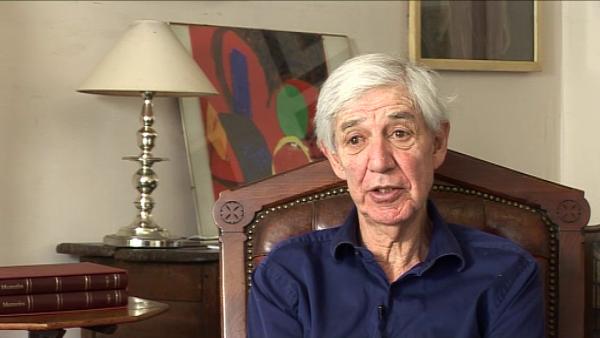NEXT STORY

Sydney Brenner: The local genius
RELATED STORIES

NEXT STORY

Sydney Brenner: The local genius
RELATED STORIES


|
Views | Duration | |
|---|---|---|---|
| 21. Consciousness | 1 | 576 | 03:09 |
| 22. The little-understood question of cells' positional identity | 363 | 04:55 | |
| 23. Sydney Brenner: The local genius | 529 | 02:09 | |
| 24. 'Reading rots the mind' | 838 | 01:04 | |
| 25. Is science dangerous? | 581 | 04:50 | |
| 26. The nonsense of bioethics | 1 | 390 | 02:11 |
| 27. Exciting ideas that ought to be researched | 339 | 02:27 | |
| 28. The relationship between evolution and development | 278 | 02:22 | |
| 29. A theory about metamorphosis | 216 | 02:05 | |
| 30. 'Soil mechanics wasn't very sexy, but then neither was cell... | 188 | 02:45 |


It’s not easy to recall in detail how I came up with the idea of positional information. I wanted to understand how the patterning of the embryo actually took place, and I certainly was very impressed with Hans Driesch’s experiment in which, when he separated the sea urchin embryo at the two-cell stage, the two cells didn’t give rise to half embryos, but to smaller, normal, whole embryos. And in fact Driesch himself had really partly predicted positional information; he also claimed that if you removed little pieces of the early embryo, the embryo still behaved normally. He was wrong, you was... there were little bits you could remove, but there were... if you removed certain bits, you couldn’t. But he claimed that you could remove any piece and it still behaved normally. And he claimed that there was a co-ordinate system whereby the cells knew their position... they knew their position. But he said — he called this entelechy — but he said this is impossible and this is some mystical thing which we’ll never understand.
I didn’t pay much attention to those ideas, and in working on Hydra, we developed a model and tried to understand why the head formed only at one end, and why it regenerated. We came up with a model in which there were graded properties along the Hydra: high at one end, and low at the other end. And also there was an inhibitor, that the head end produced an inhibitor which prevented heads forming anywhere else, and when you removed the head, of course the inhibitor went, and so you could make... you could make a new head. But that didn’t give rise directly to positional information. I really... I think the idea... I was trying to understand how cells knew what to do and... and how things were patterned, and once I came up with the idea of the French Flag, and I loved the flags, because however big or small they are they have an identical pattern, and that fitted with Driesch’s early experiment, and also the very fact that humans, from the same egg, you can get twins, and you know there’s nothing abnormal about it, that you can get the same pattern with... with half the number... with half the number of cells, that gave rise to the idea of the flag. And once you’ve got the flag, then how you would make the flag is that that you needed to think about cells having a positional identity. They knew where they... they know where they are with reference to certain boundaries. And that also enabled one to think about regeneration in a particular way. I just want to tell you there are a wide variety of amphibians which if you cut off their limbs, if you cut off the hand of a newt, it will regen... regenerate. And of course it’s now known that, or it’s now thought, we don’t fully know the molecular basis, is that there must be positional identity that determines where things are. And there are wonderful experiments now from my colleague, Jeremy Brockes, who has shown that down the newt limb, there is a graded molecule, it’s called Prod 1, it’s high here and low down here, and that possibly is giving the cells their positional identity. And you can actually change cells for positional identity with another molecule, retinoic acid. Let me tell you. Normally, if you cut at the hand end, it’ll regenerate a hand. But if while it’s regenerating, you let it sit in retinoic acid, the cells here have their concentration of Prod increased to here, so these cells now think they’re these cells, so it makes a whole new limb. It’s absolute... it’s absolutely remarkable. But of course that’s recent work and had nothing to do with the original idea of... of positional information. And of course why the Americans were so hostile to the idea in those early days, I simply don’t know. It may be related to the fact that there had been various models based on gradients — nothing to do with position — which people hadn’t liked at all.
Lewis Wolpert (1929-2021) CBE FRS FRSL was a developmental biologist, author, and broadcaster. He was educated at the University of Witwatersrand (BSc), Imperial College London, and at King's College London (PhD). He was Emeritus Professor of Biology as applied to medicine in the Department of Anatomy and Developmental Biology at University College London. In addition to his scientific and research publications, he wrote about his own experience of clinical depression in Malignant Sadness: The Anatomy of Depression (1999).
Title: The little-understood question of cells' positional identity
Listeners: Eleanor Lawrence
Eleanor Lawrence is a freelance science writer and editor, and co-author of Longman Dictionary of Environmental Science.
Tags: Hans Driesch, Jeremy Brockes
Duration: 4 minutes, 55 seconds
Date story recorded: April 2010
Date story went live: 14 June 2010